Abstract
Myeloperoxidase (MPO), H2O2, and chloride ions in the presence of bacteria form aldehydes and are bactericidal. The use of heat-inactivated MPO prevented both killing and aldehyde generation. Decarboxylation and deamination of carboxyl and amino group substrates arising from the bacterial surface may participate in the reaction which yields aldehydes. Bacterial contact was essential for killing. Decarboxylation and bactericidal activities were noted when physiological concentrations of chloride were used. When MPO was replaced with horseradish peroxidase (HPO) in the chloride medium, decarboxylation and bactericidal activities were no longer noted. In contrast, iodide functioned in the antimicrobial system with either MPO or HPO. The iodide concentrations required were at least sixfold greater than circulating blood iodide levels. Moreover, decarboxylation did not occur in the presence of iodide with either enzyme. Thus, both halides function in the MPO-H2O2 system but by different mechanisms. It is likely that in vivo under most conditions chloride is the functional halide and that generation of aldehydes is the mechanism responsible for the antimicrobial activity of the MPO-H2O2-chloride system.
Full text
PDF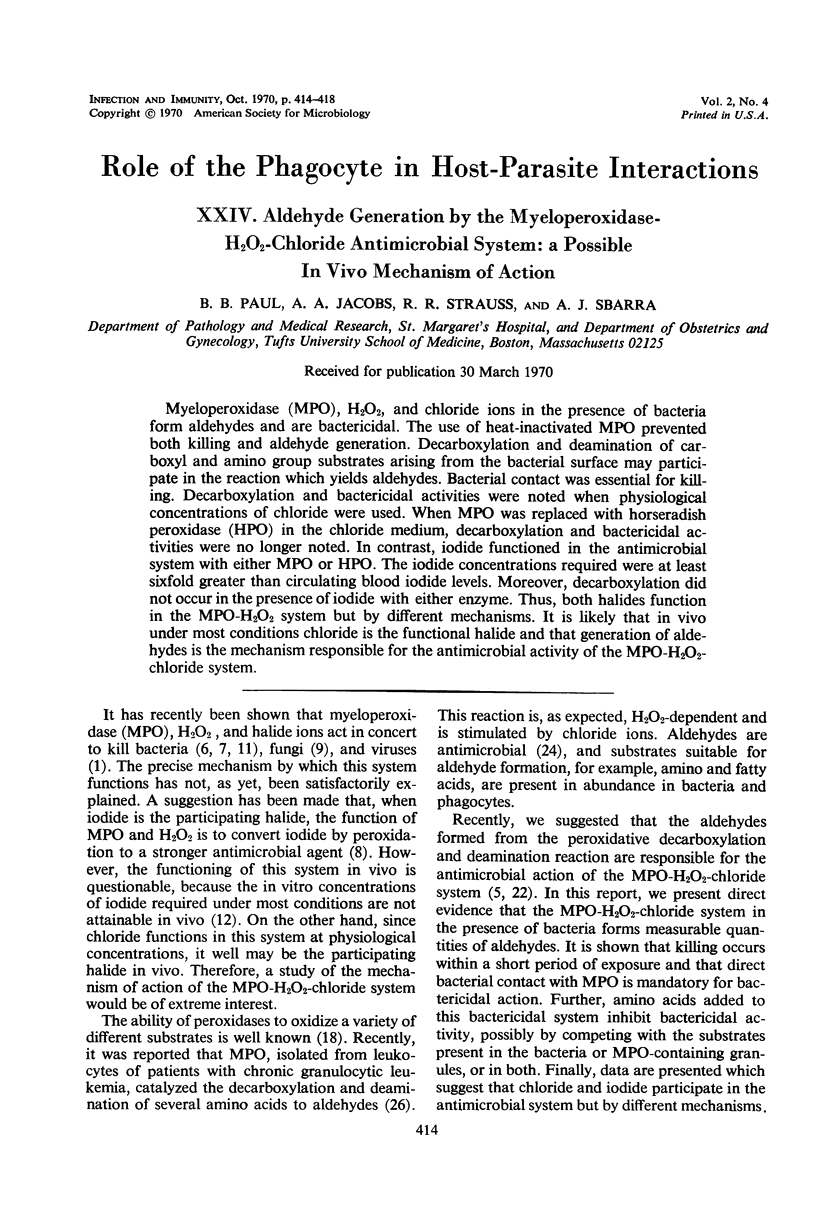
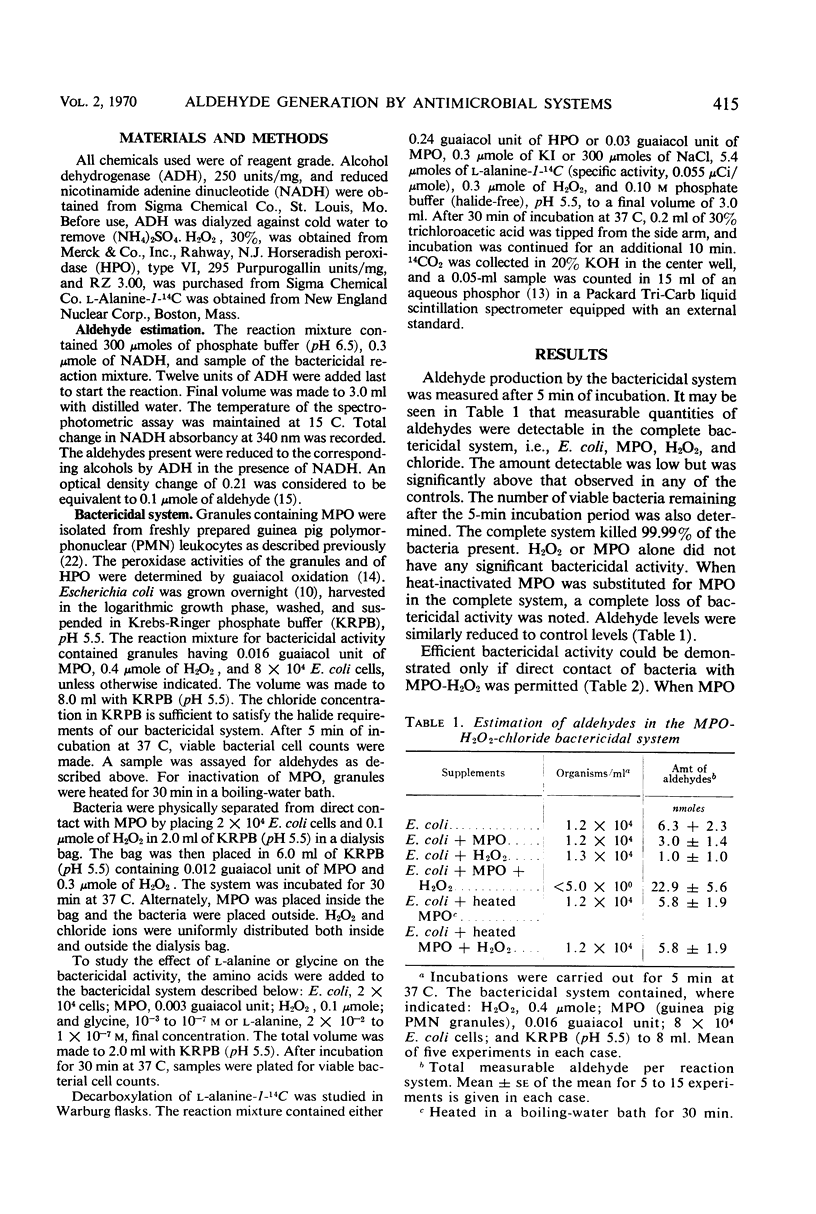
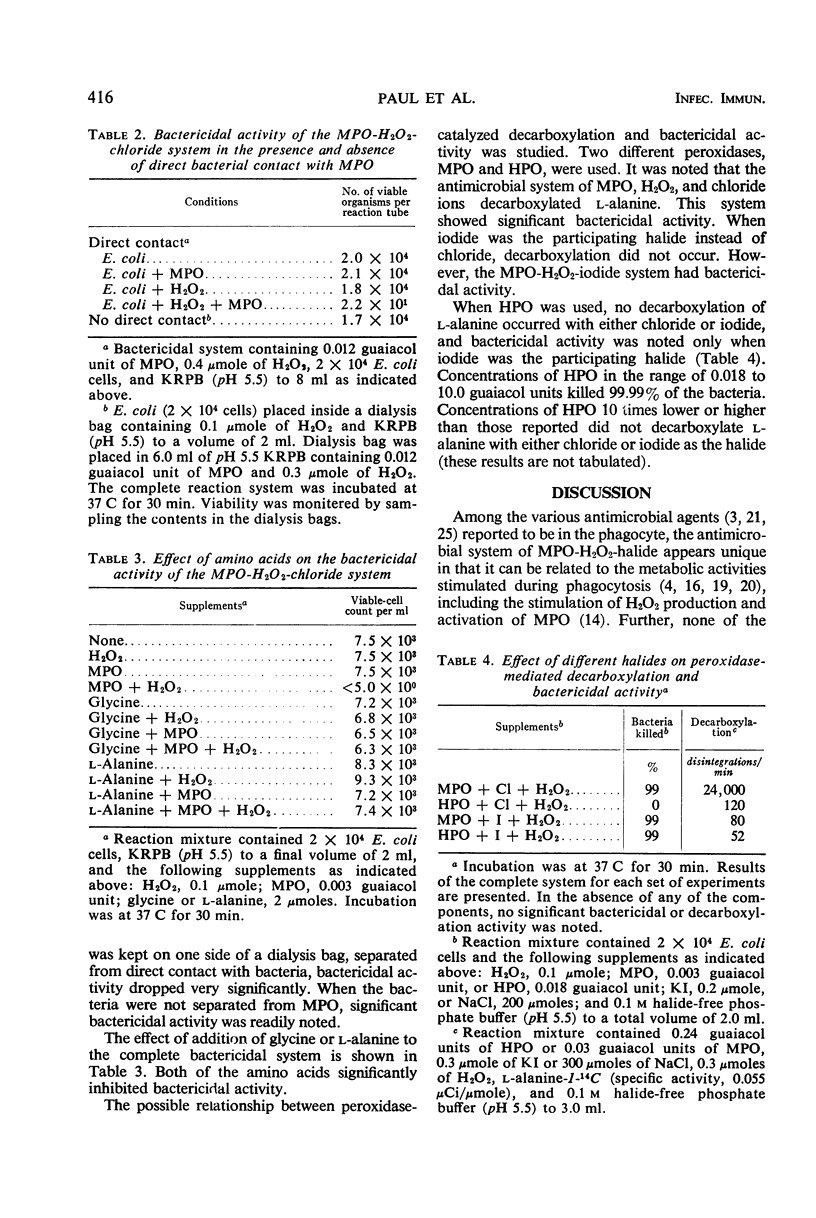
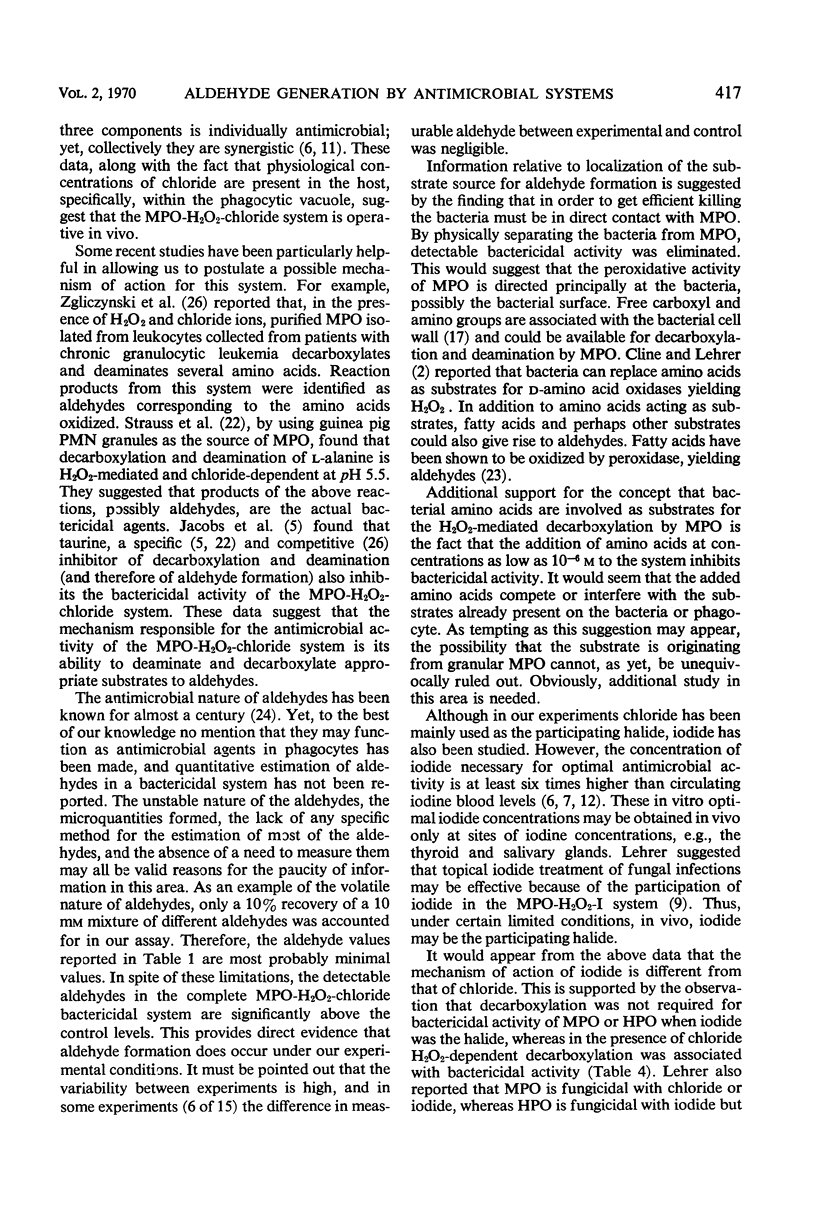
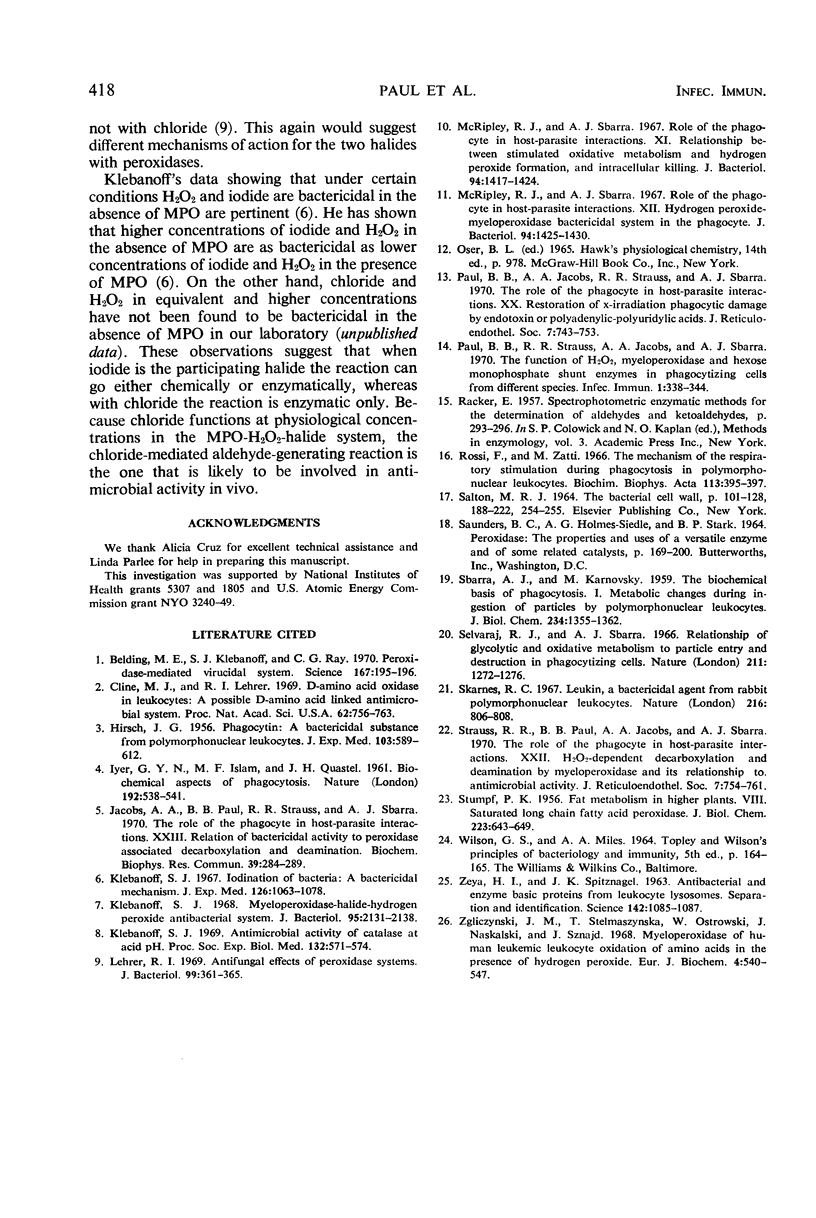
Selected References
These references are in PubMed. This may not be the complete list of references from this article.
- Belding M. E., Klebanoff S. J., Ray C. G. Peroxidase-mediated virucidal systems. Science. 1970 Jan 9;167(3915):195–196. doi: 10.1126/science.167.3915.195. [DOI] [PubMed] [Google Scholar]
- Cline M. J., Lehrer R. I. D-amino acid oxidase in leukocytes: a possible D-amino-acid-linked antimicrobial system. Proc Natl Acad Sci U S A. 1969 Mar;62(3):756–763. doi: 10.1073/pnas.62.3.756. [DOI] [PMC free article] [PubMed] [Google Scholar]
- HIRSCH J. G. Phagocytin: a bactericidal substance from polymorphonuclear leucocytes. J Exp Med. 1956 May 1;103(5):589–611. doi: 10.1084/jem.103.5.589. [DOI] [PMC free article] [PubMed] [Google Scholar]
- Jacobs A. A., Paul B. B., Strauss R. R., Sbarra A. J. The role of the phagocyte in host-parasite interactions. 23. Relation of bactericidal activity to peroxidase-associated decarboxylation and deamination. Biochem Biophys Res Commun. 1970 Apr 24;39(2):284–289. doi: 10.1016/0006-291x(70)90791-6. [DOI] [PubMed] [Google Scholar]
- Klebanoff S. J. Antimicrobial activity of catalase at acid pH. Proc Soc Exp Biol Med. 1969 Nov;132(2):571–574. doi: 10.3181/00379727-132-34263. [DOI] [PubMed] [Google Scholar]
- Klebanoff S. J. Iodination of bacteria: a bactericidal mechanism. J Exp Med. 1967 Dec 1;126(6):1063–1078. doi: 10.1084/jem.126.6.1063. [DOI] [PMC free article] [PubMed] [Google Scholar]
- Klebanoff S. J. Myeloperoxidase-halide-hydrogen peroxide antibacterial system. J Bacteriol. 1968 Jun;95(6):2131–2138. doi: 10.1128/jb.95.6.2131-2138.1968. [DOI] [PMC free article] [PubMed] [Google Scholar]
- Lehrer R. I. Antifungal effects of peroxidase systems. J Bacteriol. 1969 Aug;99(2):361–365. doi: 10.1128/jb.99.2.361-365.1969. [DOI] [PMC free article] [PubMed] [Google Scholar]
- McRipley R. J., Sbarra A. J. Role of the phagocyte in host-parasite interactions. XI. Relationship between stimulated oxidative metabolism and hydrogen peroxide formation, and intracellular killing. J Bacteriol. 1967 Nov;94(5):1417–1424. doi: 10.1128/jb.94.5.1417-1424.1967. [DOI] [PMC free article] [PubMed] [Google Scholar]
- McRipley R. J., Sbarra A. J. Role of the phagocyte in host-parasite interactions. XII. Hydrogen peroxide-myeloperoxidase bactericidal system in the phagocyte. J Bacteriol. 1967 Nov;94(5):1425–1430. doi: 10.1128/jb.94.5.1425-1430.1967. [DOI] [PMC free article] [PubMed] [Google Scholar]
- Paul B. B., Jacobs A. A., Strauss R. R., Sbarra A. J. The role of the phagocyte in host-parasite interactions. XX. Restoration of x-irradiation phagocytic damage by endotoxin or polyadenylic-polyuridylic acids. J Reticuloendothel Soc. 1970 Jun;7(6):743–753. [PubMed] [Google Scholar]
- Paul B. B., Strauss R. R., Jacobs A. A., Sbarra A. J. Function of h(2)o(2), myeloperoxidase, and hexose monophosphate shunt enzymes in phagocytizing cells from different species. Infect Immun. 1970 Apr;1(4):338–344. doi: 10.1128/iai.1.4.338-344.1970. [DOI] [PMC free article] [PubMed] [Google Scholar]
- Rossi F., Zatti M. The mechanism of the respiratory stimulation during phagocytosis in polymorphouclear leucocytes. Biochim Biophys Acta. 1966 Feb 14;113(2):395–397. doi: 10.1016/s0926-6593(66)80079-6. [DOI] [PubMed] [Google Scholar]
- SBARRA A. J., KARNOVSKY M. L. The biochemical basis of phagocytosis. I. Metabolic changes during the ingestion of particles by polymorphonuclear leukocytes. J Biol Chem. 1959 Jun;234(6):1355–1362. [PubMed] [Google Scholar]
- STUMPF P. K. Fat metabolism in higher plants. VIII. Saturated long chain fatty acid peroxidase. J Biol Chem. 1956 Dec;223(2):643–649. [PubMed] [Google Scholar]
- Selvaraj R. J., Sbarra A. J. Relationship of glycolytic and oxidative metabolism to particle entry and destruction in phagocytosing cells. Nature. 1966 Sep 17;211(5055):1272–1276. doi: 10.1038/2111272a0. [DOI] [PubMed] [Google Scholar]
- Skarnes R. C. Leukin, a bactericidal agent from rabbit polymorphonuclear leucocytes. Nature. 1967 Nov 25;216(5117):806–808. doi: 10.1038/216806a0. [DOI] [PubMed] [Google Scholar]
- Strauss R. R., Paul B. B., Jacobs A. A., Sbarra A. J. Role of the phagocyte in host-parasite interactions. XXII. H2O2-dependent decarbosylation and deamination by myeloperoxidase and its relationship to antimicrobial activity. J Reticuloendothel Soc. 1970 Jun;7(6):754–761. [PubMed] [Google Scholar]
- ZEYA H. I., SPITZNAGEL J. K. ANTIBACTERIAL AND ENZYMIC BASIC PROTEINS FROM LEUKOCYTE LYSOSOMES: SEPARATION AND IDENTIFICATION. Science. 1963 Nov 22;142(3595):1085–1087. doi: 10.1126/science.142.3595.1085. [DOI] [PubMed] [Google Scholar]
- Zgliczyński J. M., Stelmaszyńska T., Ostrowiski W., Naskalski J., Sznajd J. Myeloperoxidase of human leukaemic leucocytes. Oxidation of amino acids in the presence of hydrogen peroxide. Eur J Biochem. 1968 May;4(4):540–547. doi: 10.1111/j.1432-1033.1968.tb00246.x. [DOI] [PubMed] [Google Scholar]


